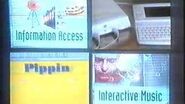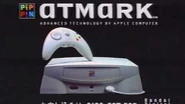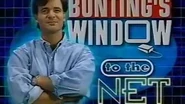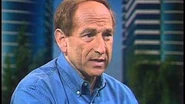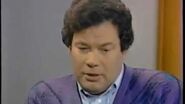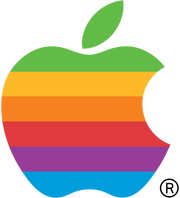
Apple's "rainbow" logo, which was in use during the Pippin era.
Apple Inc. (formerly Apple Computer, Inc.) developed the underlying technologies of Pippin platform and licensed them to Bandai and Katz Media.[1][2]
Pippin development[]
In February 1994, Apple Computer began internally developing a low cost architecture, code-named "Pippin", which would be based on a customized version of their Macintosh operating system.[3][4] In Tokyo on December 13, 1994, Apple announced its partnership with Bandai to jointly develop the Pippin platform, which would run on second-generation Power Macintosh hardware. Many Pippin discs acknowledged Apple Computer's ownership of Pippin intellectual property simply as "ACI".[1]
Apple executives[]
There were three CEOs at Apple Computer during the development and marketing of the Pippin platform:

Michael Spindler (c.1994)
- Michael Spindler (1993-1996) presided over the transition to PowerPC processors and initiated an official clone licensing program,[5] allowing 3rd-party companies such as Bandai to create Macintosh-compatible systems, thereby paving the way for the Pippin platform.[6] Spindler hoped that the Pippin would become the "savior of the company".[7] Apple had projected platform sales of 3 million units over 3 years.[8]

Gil Amelio (c.1996)
- Gil Amelio (1996-1997), an Apple board member and former CEO of National Semiconductor, took over as chairman and CEO of Apple on February 5, 1996 to turn around the struggling company.[9] Amelio stated that Apple's version of a NC device based on the Network Computer Reference Profile would be "kind of a Pippin Plus."[10] However, Amelio also pledged to cancel unprofitable projects, which included the Pippin.[11] In March 1997, Amelio presided over layoffs of 4,100 employees to stem Apple's losses as its Macintosh business was failing.[8]
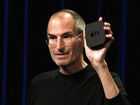
Steve Jobs (2010)
- Steve Jobs (1997-2011), one of Apple's original co-founders, returned to the company while it was continuing to face financial difficulty, and was named Interim CEO on September 16, 1997.[12] During the reorganization of Apple and its product lines, the Pippin was cancelled.[13] Technologies from the Pippin 2.0 and Macintosh NC projects were incorporated into the iMac, which Jobs introduced on May 6, 1998. The iMac would go on to sell over 800,000 units in its first year, doubling Apple's market share and returning it to profitability.[14][15][16]
Other Apple staff[]
The following staff were directly involved with developing or marketing the Pippin platform:
- Satjiv Chahil, general manager of new media, internet, and entertainment.[17]
- Jackie Friedman, Pippin marketing and business development.[18]
- Rick Johnson, industrial design.[3][19]
- Bill Knott, software engineer.[20][21]
- Mark Orr, business development manager.[22]
- Ray Riley, industrial design.[3][19]
- Eric R. Sirkin, director of Macintosh OEM products.[8]
- Richard Sprague, Pippin liaison.[8]
- Jeff Tanner, lead software engineer.[23]
- Mark Wu, Pippin marketing and business development.[18]
Other television projects[]
- Apple Interactive Television Box (1994-1996), Apple's previous effort to develop a set-top box.
- Apple TV (2007-present), Apple's current digital media player and microconsole.
- Mac mini (2005-present), Apple's small desktop computer which added HDMI output in 2010.
- Macintosh TV (1993-1994), Apple's first attempt to integrate a computer and television.
Gallery[]
Promotional videos[]
Media coverage[]
Interviews[]
References[]
- ↑ 1.0 1.1 Bandai Pippin FAQ, The Mac Geek.
- ↑ Katz Media Signs Worldwide Licensing Agreement for Apple's Pippin Technology, Katz Media SARL. Archived 1997-07-13.
- ↑ 3.0 3.1 3.2 Mais qui a créé le design de la Pippin ? (French) by Pierre Dandumont, Le Journal du Lapin. 2019-03-10.
- ↑ AppleDesign: The Work of the Apple Industrial Design Group, p.263-264 by Paul Kunkel and Rick English. Graphis Inc. 1997-10-01.
- ↑ Apple Alumni: Where are they now? Michael Spindler by Connie Guglielmo, Forbes. 2012-10-04.
- ↑ Apple's biggest flop? A requiem for the Apple Bandai Pippin games console by Emma Boyle, TechRadar. 2017-03-10.
- ↑ Apple's Pippin: A Pip--or a Pipsqueak? by Peter Burrows, BusinessWeek. 1996-04-01. Archived 2013-06-04.
- ↑ 8.0 8.1 8.2 8.3 The Mac gaming console that time forgot by Richard Moss, Ars Technica. 2018-03-24.
- ↑ Gil Amelio's Insanely Great Paycheck by Peter Burrows, Bloomberg. 1996-02-26.
- ↑ NC coalition frames plans for Net boxes by James Staten, MacWeek vol.10-21. 1996-05-27. Archived 1996-12-20.
- ↑ Amelio: Promises made, not always kept, C|NET. 1997-07-16.
- ↑ Jobs named interim Apple CEO, C|NET. 1997-09-16.
- ↑ For the good of the company? Five Apple products Steve Jobs killed by Casey Johnston, Ars Technica. 2011-08-25.
- ↑ Options will make Pippin 2 a home, network computer by David Morgenstern, MacWeek vol.10-37. 1996-09-30. Archived 1996-12-20.
- ↑ Keynote Addresses - Larry Tesler by Carolyn B. Mitchell, H. T. Kung, The Harvard Conference on the Internet & Society. 1997.
- ↑ #1 Temporal Loop - Birth of the iMac by Thomas Hormby, The Mac Observer. 2007-05-25.
- ↑ Apple 1988-1997, Satjiv S. Chahil. 1996-01-18.
- ↑ 18.0 18.1 Apple's Defunct Mulitimedia Appliance Pippin Promo Pt.1 by Grooveraider, YouTube. 2007-08-13.
- ↑ 19.0 19.1 AppleDesign: The Work of the Apple Industrial Design Group, p.201 by Paul Kunkel and Rick English. Graphis Inc. 1997-10-01.
- ↑ Apple's Pippin Platform, IMUG Events. 1996-07-18.
- ↑ Viewpoint by Scott T. Boyd, MacTech, vol.11. 1995-07.
- ↑ Reinventing the Home Computer by Chris O'Malley, Popular Science, p.78. 1996-11.
- ↑ Jeff Tanner, LinkedIn. Accessed 2019-04-22.
External links[]
- Apple's original Pippin site (archived 1997-04-14)
- Pippin: Questions and Answers part 1 and 2 at Apple (2012-02-19)
- Apple Inc. at the Adobe Wiki
- Apple Inc. at the Apple Wiki
- Apple Inc. at Wikipedia

